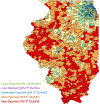Where you live matters: Area deprivation predicts poor survival and liver transplant waitlisting
- PMID: 38346498
- PMCID: PMC11070293
- DOI: 10.1016/j.ajt.2024.02.009
Where you live matters: Area deprivation predicts poor survival and liver transplant waitlisting
Abstract
Social determinants of health (SDOH) are important predictors of poor clinical outcomes in chronic diseases, but their associations among the general cirrhosis population and liver transplantation (LT) are limited. We conducted a retrospective, multiinstitutional analysis of adult (≥18-years-old) patients with cirrhosis in metropolitan Chicago to determine the associations of poor neighborhood-level SDOH on decompensation complications, mortality, and LT waitlisting. Area deprivation index and covariates extracted from the American Census Survey were aspects of SDOH that were investigated. Among 15 101 patients with cirrhosis, the mean age was 57.2 years; 6414 (42.5%) were women, 6589 (43.6%) were non-Hispanic White, 3652 (24.2%) were non-Hispanic Black, and 2662 (17.6%) were Hispanic. Each quintile increase in area deprivation was associated with poor outcomes in decompensation (sHR [subdistribution hazard ratio] 1.07; 95% CI 1.05-1.10; P < .001), waitlisting (sHR 0.72; 95% CI 0.67-0.76; P < .001), and all-cause mortality (sHR 1.09; 95% CI 1.06-1.12; P < .001). Domains of SDOH associated with a lower likelihood of waitlisting and survival included low income, low education, poor household conditions, and social support (P < .001). Overall, patients with cirrhosis residing in poor neighborhood-level SDOH had higher decompensation, and mortality, and were less likely to be waitlisted for LT. Further exploration of structural barriers toward LT or optimizing health outcomes is warranted.
Keywords: cirrhosis; community; neighborhood; social determinants of health; transplant; waitlist.
Copyright © 2024 American Society of Transplantation & American Society of Transplant Surgeons. Published by Elsevier Inc. All rights reserved.
Conflict of interest statement
Declaration of competing interest The authors of this manuscript have no conflicts of interest to disclose as described by the American Journal of Transplantation. Lisa VanWagner serves as an advisor for Numares, Novo-Nordisk, and Gerson Lehrman Group, receives grant support from W.L. Gore & Associates, and provides expert witness services outside the submitted work. The other authors of this manuscript have no conflicts of interest to disclose.
Figures




Similar articles
-
Social Disadvantage and Disparities in Chronic Liver Disease: A Systematic Review.Am J Gastroenterol. 2024 Oct 30;120(7):1548-1566. doi: 10.14309/ajg.0000000000003171. Am J Gastroenterol. 2024. PMID: 39471468 Free PMC article.
-
Neighborhood-level Social Determinants of Health and Waitlist Mortality for Liver Transplantation: The Liver Outcomes and Equity Index.Transplantation. 2024 Jul 1;108(7):1558-1569. doi: 10.1097/TP.0000000000004888. Epub 2024 Jun 20. Transplantation. 2024. PMID: 38049937 Free PMC article.
-
Are Detailed, Patient-level Social Determinant of Health Factors Associated With Physical Function and Mental Health at Presentation Among New Patients With Orthopaedic Conditions?Clin Orthop Relat Res. 2023 May 1;481(5):912-921. doi: 10.1097/CORR.0000000000002446. Epub 2022 Oct 6. Clin Orthop Relat Res. 2023. PMID: 36201422 Free PMC article.
-
Association of Community Socioeconomic Distress With Waitlist and Survival Outcomes in Liver Transplantation.Transplantation. 2025 Jun 1;109(6):976-984. doi: 10.1097/TP.0000000000005328. Epub 2025 Jan 9. Transplantation. 2025. PMID: 39780308
-
Home treatment for mental health problems: a systematic review.Health Technol Assess. 2001;5(15):1-139. doi: 10.3310/hta5150. Health Technol Assess. 2001. PMID: 11532236
Cited by
-
Exploring Caregiver Support as a Potential Mediator of Neighborhood Socioeconomic Disadvantage and Reduced Likelihood of Liver Transplant Waitlisting.Transplant Direct. 2025 Mar 28;11(4):e1782. doi: 10.1097/TXD.0000000000001782. eCollection 2025 Apr. Transplant Direct. 2025. PMID: 40166626 Free PMC article.
-
Social Disadvantage and Disparities in Chronic Liver Disease: A Systematic Review.Am J Gastroenterol. 2024 Oct 30;120(7):1548-1566. doi: 10.14309/ajg.0000000000003171. Am J Gastroenterol. 2024. PMID: 39471468 Free PMC article.
References
Figure 2. References
-
- Kardashian A, Serper M, Terrault N, et al. Health disparities in chronic liver disease. Hepatology 2022;00:1–22. Available at: https://onlinelibrary.wiley.com/doi/full/10.1002/hep.32743 [Accessed September 12, 2022]. - DOI - PMC - PubMed
-
- Mohamed KA, Ghabril M, Desai A, et al. Neighborhood poverty is associated with failure to be waitlisted and death during liver transplantation evaluation. Liver Transplantation 2022;28:1441–1453. Available at: https://onlinelibrary.wiley.com/doi/abs/10.1002/lt.26473 [Accessed August 18, 2023]. - DOI - PMC - PubMed
Publication types
MeSH terms
Grants and funding
LinkOut - more resources
Full Text Sources
Medical

